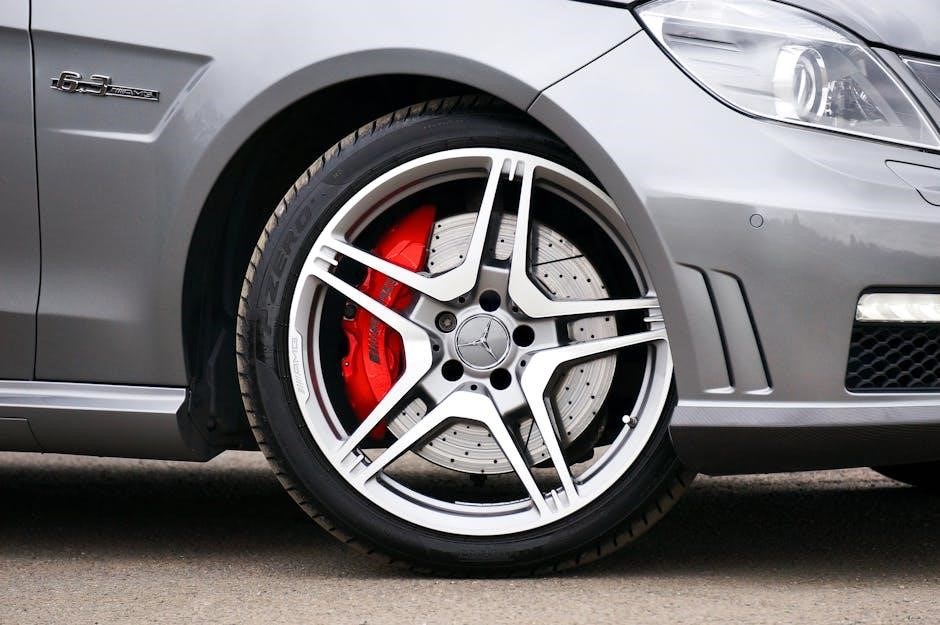Proper tyre pressure is crucial for Mercedes vehicles, affecting safety, fuel efficiency and performance, with guidelines found on the fuel door or in the owner’s manual, typically between 32 and 35 PSI for most models, every day.
Importance of Maintaining Tyre Pressure
Maintaining the correct tyre pressure is essential for Mercedes vehicles as it affects the overall safety, fuel efficiency, and performance of the vehicle. Properly inflated tyres can improve handling, reduce the risk of accidents, and enhance the driving experience. Additionally, correct tyre pressure can also help to reduce fuel consumption, lower emissions, and prolong the lifespan of the tyres. Underinflated tyres, on the other hand, can lead to reduced traction, increased stopping distances, and a higher risk of tyre failure. Furthermore, maintaining the recommended tyre pressure can also help to prevent uneven tyre wear, which can lead to costly repairs and replacements. By regularly checking and maintaining the correct tyre pressure, Mercedes owners can ensure a smoother, safer, and more enjoyable driving experience. The importance of maintaining tyre pressure cannot be overstated, and it is a crucial aspect of vehicle maintenance that should not be neglected. Regular checks and maintenance can help to prevent a range of problems and ensure the vehicle runs at its best.

Checking Tyre Pressure in Mercedes Vehicles
Mercedes owners can check tyre pressure using a gauge, found on the fuel door or in the owner’s manual, with morning time being the best time for accuracy, every day, always.
Location of Tyre Pressure Information
The location of tyre pressure information is crucial for Mercedes owners to know, as it can be found on the inside of the fuel door, on a sticker or placard, or in the owner’s manual. This information is specific to each vehicle, taking into account the make, model, and year of the Mercedes. The fuel door is usually the most convenient place to find this information, as it is easily accessible and provides the recommended tyre pressure for the front and rear tyres. Additionally, the owner’s manual may also provide more detailed information on tyre pressure, including the recommended pressure for different driving conditions, such as highway driving or towing. It is essential to check the owner’s manual or the fuel door for the correct tyre pressure information, as it may vary depending on the vehicle. By knowing the correct location of tyre pressure information, Mercedes owners can ensure their tyres are properly inflated, which can improve safety, fuel efficiency, and overall performance. Furthermore, proper tyre inflation can also help to prevent tyre damage and extend the life of the tyres.

Understanding Recommended Tyre Pressure
Recommended tyre pressure varies by vehicle, with most Mercedes models requiring between 32 and 35 PSI for optimal performance and safety, as specified by the manufacturer, every time, always.
General Guidelines for Tyre Pressure
General guidelines for tyre pressure in Mercedes vehicles suggest that most models require a pressure between 32 and 35 PSI for optimal performance and safety. The owner’s manual or the tyre information placard on the fuel door can provide specific guidance for individual vehicles. It is essential to note that tyre pressure can vary depending on the load, driving conditions, and weather. Additionally, tyre pressure should be checked regularly, at least once a month, and before long trips. Many Mercedes models come equipped with tyre pressure monitoring systems, which can provide real-time information on tyre pressure. However, it is still important to check tyre pressure manually to ensure accuracy. By following these general guidelines and referring to the manufacturer’s recommendations, Mercedes owners can help ensure their vehicles are running safely and efficiently. Regular tyre pressure checks can also help to extend the life of the tyres and improve fuel economy. Proper tyre pressure is crucial for overall vehicle maintenance.

Tyre Pressure Monitoring Systems in Mercedes
Mercedes vehicles often feature advanced tyre pressure monitoring systems for enhanced safety and efficiency, providing real-time pressure updates to drivers, every time, always.
Benefits of Tyre Pressure Monitoring
Tyre pressure monitoring systems offer numerous benefits to Mercedes drivers, including improved safety, increased fuel efficiency, and enhanced vehicle performance. By providing real-time tyre pressure updates, these systems help prevent accidents caused by underinflated tyres. Additionally, proper tyre pressure can lead to better fuel economy, reducing the financial and environmental impact of driving. Furthermore, tyre pressure monitoring systems can also help extend the lifespan of tyres, reducing the need for frequent replacements. With the ability to monitor tyre pressure at all times, drivers can enjoy a more comfortable and secure driving experience. The systems can also detect potential tyre problems, allowing drivers to take preventive measures and avoid costly repairs. Overall, the benefits of tyre pressure monitoring systems make them a valuable feature in Mercedes vehicles, providing drivers with peace of mind and a more enjoyable driving experience, every time they get behind the wheel.
